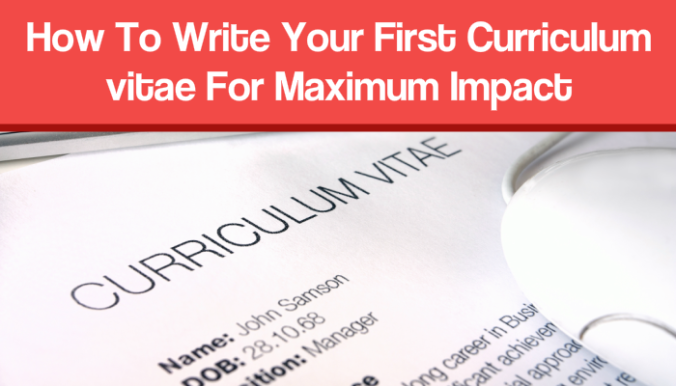
There’s no question that writing your very first curriculum vitae can be a fairly daunting task.
Writing a CV when you have some jobs and experience under your belt is one thing, but for the very first one, there’s a good chance that you are a student that also means you don’t have a lot of jobs or professional experience that most curriculum vitae’s require.
The good news is that there are always starter jobs that are open to individuals who need to get their start in life, but that doesn’t excuse you from that critical first step of learning to create a curriculum vitae.
First, Let’s Brainstorm
There’s no question what the first step should be. Just because you haven’t had an official job or internship before doesn’t mean you don’t have various experiences, skills, and talents that can help you impress an employer and be the one person who gets your foot in the door – even with less experience.
 However, the only way to put your best foot forward is to brainstorm. You need to think about the different experiences you’ve had, the different groups, charities, or volunteer work you’ve associated with, or anything that can translate to the specific skills or attitudes that an employer might be looking for.
However, the only way to put your best foot forward is to brainstorm. You need to think about the different experiences you’ve had, the different groups, charities, or volunteer work you’ve associated with, or anything that can translate to the specific skills or attitudes that an employer might be looking for.
This also brings up a great point: customise your curriculum vitae. Cooking for dozens of Boy Scout camp outs or on a farm is great background for a restaurant cook job. On the other side of things, it doesn’t mean anything for a phone or office job. The best curriculum vitae’s are tailored towards specific jobs that are being applied for.
Employers don’t expect you to have an empty sheet of paper in the beginning. Especially when starting out on those early job hunts, a curriculum vitae doesn’t need just past employment. High school or college clubs and organisations that show skills, leadership, or charity work can all make a difference in the beginning.
Talk about specific skills. Can you repair a car or tractor engine? Do you know a computer programming language? Have you built websites or been published in the local newspaper? There are many ways to put together a good beginning curriculum vitae.
Organise Your Ideas Into A Proper Curriculum Vitae
Once you’ve done the brainstorming and have your building blocks and pieces of information to now work with, now it is time to set up a true Curriculum Vitae. When it comes to the pure nuts and bolts, there are several different ways to tackle putting together a proper CV.
Just make a simple search online and you will be able to see dozens if not hundreds of examples of how various people have put together their CV. Choose a recent format that makes sense for what the position you are applying.
The next step is to work on a strong summary. You need  to get the attention of a hiring manager quickly and make a good impression off the bat.
to get the attention of a hiring manager quickly and make a good impression off the bat.
The good news is that by starting your curriculum vitae with a general summary statement that talks about strengths, goals, pitches you really well, that can be enough to at least get your foot in the door for a face to face interview.
Some of the benefits proving hard work can mean education or a list of extracurricular activities that you participated. This might not be as good as an impressive job history but it displays the ability to work hard and that is important.
After the first summary detail your experience. If you’ve had some part-time job or helped with a family business, great. If not, this is where internships, related volunteer work, or other related activities go.
After your experience, it comes to the more flexible part of your CV to give more information. Volunteer groups, relevant classes that work, look at extracurricular activities, specific skills, adventures, or anything that can set you apart in a truly positive way and get the interest of those you are dealing with.
Proofread Multiple Times
Proofreading is an obvious and critical step. This isn’t just to put your best foot forward, but it allows you to re-read and re-edit your curriculum vitae to put together the best possible first impression. This is not a step to take lightly because no matter how the rest of your curriculum vitae impresses, a simple typo will be more than enough to sink your chances!
I hope this article helps to put together your very first CV and I wish you all the success in your professional endeavours.